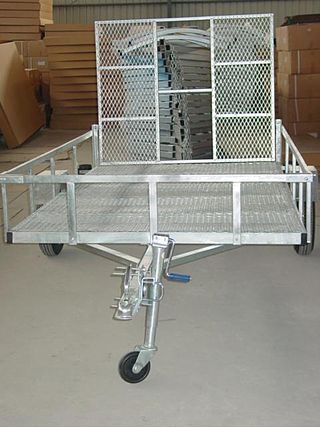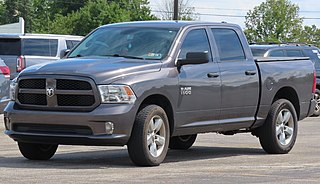
A semi-trailer truck, is the combination of a tractor unit and one or more semi-trailers to carry freight. A semi-trailer attaches to the tractor with a type of hitch called a fifth wheel.

An anti-lock braking system (ABS) is a safety anti-skid braking system used on aircraft and on land vehicles, such as cars, motorcycles, trucks, and buses. ABS operates by preventing the wheels from locking up during braking, thereby maintaining tractive contact with the road surface and allowing the driver to maintain more control over the vehicle.

The Ford Explorer is a range of SUVs manufactured by Ford Motor Company since the 1991 model year. As the first four-door SUV produced by Ford, the Explorer was introduced as a replacement for the two-door Bronco II. Within the current Ford SUV range in North America, the Explorer is slotted between the Ford Edge and Ford Expedition. As with the Ford Ranger, the Explorer derives its name from a trim package previously offered on the Ford F-Series pickup trucks.

A trailer is an unpowered vehicle towed by a powered vehicle. It is commonly used for the transport of goods and materials.

The Ford Expedition is a full-size three-row SUV, manufactured by Ford. Introduced for the 1997 model year as the successor of the Ford Bronco, the Expedition was the first full-size Ford SUV sold with a four-door body. For its entire production life, the Ford Expedition has been derived from the corresponding generation of the Ford F-150 in production, sharing some body and mechanical components. The fourth-generation Ford Expedition began production for the 2018 model year. Similar to the configuration of the Chevrolet Tahoe and Suburban, the Ford Expedition is sold in regular and extended lengths ; sold since 2007, the latter functionally serves as the replacement for the Ford Excursion.

The Ford Excursion is a heavy duty, full-sized SUV that was sold by Ford from 2000 to 2005. The third SUV derived from the Ford F-Series, the model line was the longest and heaviest SUV ever to enter mass production at the time. Slotted above the Expedition in the Ford model line, the Excursion was sold nearly exclusively in North America; limited numbers of the model line were produced for export.

The Ram pickup is a full-size pickup truck manufactured by Stellantis North America and marketed from 2010 onwards under the Ram Trucks brand. The current fifth-generation Ram debuted at the 2018 North American International Auto Show in Detroit, Michigan, in January of that year.

The Ford Bronco is a model line of SUVs manufactured and marketed by Ford. The first SUV model developed by the company, five generations of the Bronco were sold from the 1966 to 1996 model years. A sixth generation of the model line was introduced for the 2021 model year. The nameplate has been used on other Ford SUVs, namely the 1984–1990 Bronco II compact SUV and the 2021 Bronco Sport compact crossover.

The Ford Super Duty is a series of heavy-duty pickup trucks produced by the Ford Motor Company since the 1999 model year. Slotted above the consumer-oriented Ford F-150, the Super Duty trucks are an expansion of the Ford F-Series range, from F-250 to the F-600. The F-250 through F-450 are offered as pickup trucks, while the F-350 through F-600 are offered as chassis cabs.

The International Extreme Truck Series is a range of pickup trucks produced by Navistar International from 2004 to 2008. The first International-brand vehicle marketed for non-commercial sale since 1980, the XT line also marked the return of the company to pickup truck production since the final generation of the (smaller) Light Line pickup trucks in 1975.

A tow hitch is a device attached to the chassis of a vehicle for towing, or a towbar to an aircraft nose gear. It can take the form of a tow ball to allow swiveling and articulation of a trailer, or a tow pin, or a tow hook with a trailer loop, often used for large or agricultural vehicles where slack in the pivot pin allows similar movements. Another category is the towing pintle used on military vehicles worldwide.

The Ural-5323 is an 8×8 heavy-duty off-road truck specially designed for army service. It has been produced since 1989 by the Ural Automotive Plant located in Miass, Russia.

Towing is coupling two or more objects together so that they may be pulled by a designated power source or sources. The towing source may be a motorized land vehicle, vessel, animal, or human, and the load being anything that can be pulled. These may be joined by a chain, rope, bar, hitch, three-point, fifth wheel, coupling, drawbar, integrated platform, or other means of keeping the objects together while in motion.

Brake-by-wire technology in the automotive industry is the ability to control brakes through electronic means, without a mechanical connection that transfers force to the physical braking system from a driver input apparatus such as a pedal or lever.
A brake controller is usually an original equipment manufacturer or aftermarket-installed device or module. It is mounted to the tow vehicle's driver's-side dashboard area, and engages a trailer's electrical braking system either time delayed, or in proportion to the tow vehicle's brake engagement when slowing down or coming to a halt. A brake controller is not needed with a trailer surge braking system unless using modern electric over hydraulic devices. The trailer in this case usually has either electric friction brakes or electric-hydraulic trailer brake actuators.

The Tatra 138 was a truck produced in Czechoslovakia by the Tatra company. The immediate successor to the Tatra 111, the model introduced a number of new features while continuing the evolution of Tatra concept. The truck was produced from 1959 to 1971.

The Ford L-series is a range of commercial trucks that were assembled and marketed by Ford between 1970 and 1998. They are also known as Ford Louisville or, for the 1990s aerodynamic models, Ford Aeromax. The first dedicated Class 8 truck produced by the company, although Ford had been producing "Heavy Duty" trucks since 1948 and their "Super Duty" lineup since 1958. The L-Series was the successor of the F-900/F-1000 Super Duty and the Ford N-Series. The line encompassed a wide range of models in GVWR Classes 6 through 8, as either straight trucks or as semi-tractors, with vehicles developed for medium-duty, on-highway, severe-service, and vocational applications.

The eighth generation of the Ford F-Series is a line of pickup trucks and light- to medium-duty commercial trucks produced by Ford from 1987 to 1991. While the 1980 cab and chassis was carried over to the new model, the 1987 model was more streamlined, and maintenance items were made simpler. The exterior was facelifted with new composite headlamps, a more aerodynamic front end, and circular fenders. Inside, the interior was given a complete redesign. Rear antilock brakes were now standard, the first pickup truck to boast this. For the first time, all models were produced with straight-sided Styleside beds; the Flareside bed was discontinued except for a small number of early 1987 models using leftover 1986 beds with new circular fenders. In 1991, Ford premiered the 9th gen taillights on the last year of the 8th generation.
A number of standards prevail in North America, or parts of it, for trailer connectors, the electrical connectors between vehicles and the trailers they tow that provide a means of control for the trailers.